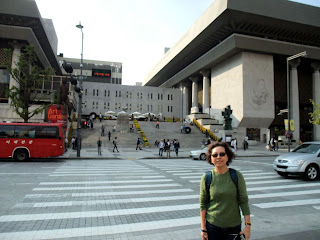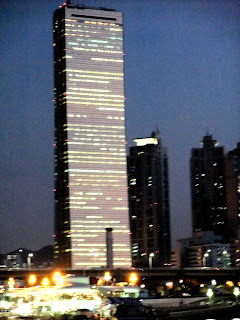
The mega city of Seoul with a population of more than 10 millions people, is surrounded by 4 large gates and 4 small gates built in the fortress walls at 4 different directions of east, west, south and north. Respectively, all 4 gates were inscribed with four Korean letters with meaning of perfect virtue, justice, civility and wisdom. The letter at Great East Gate which means Perfect Virtue was inserted on the tablet to reinforce the energy of the flat land in front.


The Great East Gate, Heunginjimun was originally built in year 1398 during the reign of King Taejo and later rebuilt in 1869. The architectural characteristic of 19th century was found in the two story buildings Gate Houses which were only appeared at the arch passage of East and South Gates. Gate House was used as a command post during emergency and where the commander stayed.


Brick walls and wooden plate windows were installed outside the gatehouse with a crescent shaped revetment in front. These were to defend the city against enemies and invaders.


Seoul is one of the largest city in the world. It is not only a foremost economic, political center of South Korea but also a rich cultural heritage of its pasts. Places like Dongdoemum historical cultural park stadium can be easily met right at the heart of the city.


Surrounding areas near Dondaemun are bursting with cultural events, buzzing nightlife and lively eating spots.


Dongdaemun Market is the largest traditional retailing and wholesale market near the gate after Namdaemun, the oldest wooden gate which was burnt down by fire on year 2008.


Laughing communication! I laughed because she could not understand what I said and she laughed as she could not get what I mean. We hugged and the deal was closed. Smiling is always the easiest way in transmission of understanding.


The interesting street food in Seoul! One stick one US$, not too cheap but good taste.


Gwanghwamun was changed to its present name from Jeongmun by King Sejong of Joseon Dynasty to represent a bright, great and righteous orders and messages delivered by Emperor.


Gwanghwamun Square competes with the rich historical and cultural resources nearby and serves as a major landmark and new tourist attraction of the city.


Site of Hwangtohyeon, four ways junction between Sungnyemun and Gwanghwamun, was originally a low hill at the end of Yukjo Street but leveled flat in 1909 by Japanese and a road was built to connect the two places. The central 6 lanes were converted to a square allowing pedestrians to access to the surrounding areas and commercial centers nearby.


Road in front of Gwanghwamun refereed as Yukjo ( 6 ministries) Streets as it was lined with buildings of 6 ministries along with others in Joseon Period. All buildings were dismantled under Japanese Rule and lost its symbolic significance. Today Yukjo has been restored and established into a historical site with symbolic features on display.


Statue of King Sejong (15-05-1397) an emperor who invented the most significant cultural heritage of Korean, Hangeul (Korean Alphabet). He brought glory to his nation with outstanding accomplishments in politics, culture, art, science, agriculture and astronomy.


Sejong Story Exhibition Hall is at the basement of the Gwanghwamun Square to dedicate the great king and honor his life and achievements. The king's democracy ideas and invention of Hangeul, became a cultural landmark of Korea.



The statue of Haechi (Admiral Lee Sun Sin) at the waterways of History. There also has an Art Gallery of Haechi Madang underneath the square.


A royal parade at Gwanghwamun Square at amidst of office blocks and busy streets, a contrast of the past and present.



Gwanghwamun is an office town. Korea people work hard and play hard. The 20 million residents in Seoul National Capital Area worked for long hours and their hard work had helped transforming the country into an economy power in last half century.



The Korean alphabet Hangeul , a ginseng plant and ginkgo tree. Trees-lined street repleted with shops at the center of Seoul City.



Shinsegae (New World) near Myeongdong District is a shopping complex of international high end and world branded products. Its washrooms are even more luxurious than 5-stars hotels.

Shinsegae at night and entrance of Myeongdong market district. Restaurant promoter in spider man costume hanging with food menu walking round the streets to attract attention from customers.



Korean street food was really interesting. We enjoyed the food more than shopping.


The grilled chestnut cost US$3-5.00 for just 5-8 pieces while the fresh figs were equally expensive, at US$15 for less than 10 pcs.


The day view and night scene of the tallest building at Seoul, The KLI 63 Building.



There are a total of 27 bridges within Seoul National Capital Area, from west to east, crossing over Han River which is though not the longest, the most important in Seoul.





There are 7 subway lines crossing over the river in which one is through a tunnel beneath the riverbed.






Ferry cruise departs from four areas along Han River and most well known one is Yeoido as the place has a variety of facilities like bikers and skaters services on the smooth paved paths and walkways along the river. Various restaurants and cafes are available at the paths.


Enjoy riding the ferry cruise boat in the evening hours to experience a different sunset atmosphere in the city light and river breeze. .




First floor and front section of the boat offers great views of this 2000 years old major settlement of Korea Capital City



Han River was the site of Olympic Rowing regatta when Seoul held The Olympic Games in 1988.




The notable high buildings in the city includes Seoul Tower, Samsung Tower Palace and LG Twin Towels and The KLI 63 Building.



When the sun starting to go down, Han River comforted by soft winds, becomes a romantic place under the golden sky.








The river comes alive at night with lighted up bridge and glimmering city light in an unique atmosphere.


Han River is the combination of Namhan and Bukhan River with a total length of 514km. The width within the city was controlled to be within one km. It flows through Seoul and merges with Imjin River shortly before it enters into Yellow Sea on the west. Night views of the city lights create a dreamy effect from the deck.




Han River was used to be a trade route to China via Yellow Sea during 3-Kingdom period but no longer actively used fro navigation as its estuary, located at the borders of North and South Korea, was barred from entrance by any civilian.


The material of straw waste became an innovative wall decoration at one of the local residence, and an old lady in traditional Hanbok at a wedding ceremony.


Hotel Samjung where we stayed was ready to welcome the foreign guests of G20 Seoul Summit.


Grand fore entrance of Hotel Samjung.


There are special dedicated buses for just foreigners only. Their consideration made most visitors feel warm and comfortable.


The bus station of Seoul is huge and systematic. We were just like at airport, check in and boarding. The only problem is that there was no indication in any other languages other than Korean and no many people can speak English. To make sure you go the right direction, step on the right lane and board the right bus to the right destination, you must spare with ample time for making inquiries around.


A sea of pink algae along the way from Seoul to Incheon Airport.


Wishing pool and Statue of musical orchestra in traditional costumes at the departure hall of Incheon Airport.





No comments:
Post a Comment